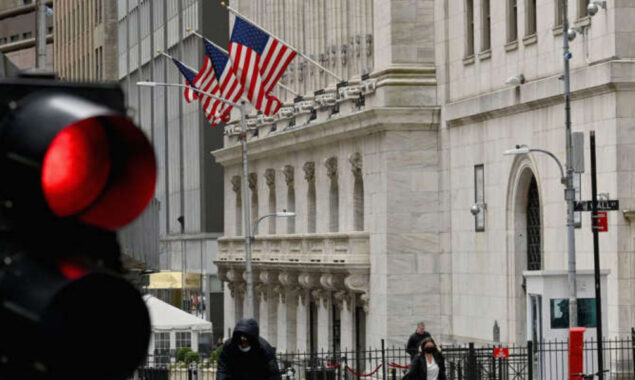Synopsis
Despite their fortress balance sheets and stress tests, banks in the United States have been weakened this year as inflation and the risk of a recession weigh on Wall Street's mightiest.

Despite their fortress balance sheets and stress tests, banks in the United States have been weakened this year as inflation and the risk of a recession weigh on Wall Street’s mightiest.
Investors have flashed a giant red signal at the six major publicly traded United States banks, which have underperformed the market and lost $257 billion of their combined $1.44 trillion market cap since the beginning of the year. (See graph.)
Goldman Sachs Group Inc. (down 18.1 percent year-to-date) and JPMorgan Chase & Co. are Dow Jones Industrial Average components that have seen enormous wealth evaporation (down 22.3 percent ). Wells Fargo & Co. (down 7.1 percent), Bank of America (down 18.1 percent), Citigroup (down 16.8 percent), and Morgan Stanley are among the other members of the ailing stock megaclub (down 16.1 percent ).
Except for Wells Fargo, the group’s performance is worse than the Dow 30’s 8.4% year-to-date loss and the S& P 500’s 12.2% year-to-date loss. The Finance Select Sector SPDR ETF is down 9.6%, and the KBW Nasdaq Bank Index is down almost 15% in the larger banking and financial sector.
Capital markets have seized up, at least in terms of initial public offerings and other deal-making, with headwinds from the Ukraine war, rising prices, market volatility, and the Fed preparing to hike interest rates.
Bank earnings fell in the first quarter, despite a bumper crop of deal-making and recovery in the first quarter of 2021, as their investment banking activity fell and their capital ratios were hurt by price declines in the Treasury market.
The bank’s weaker capital ratios, according to Ellen Hazen, chief market analyst and portfolio manager at F.L. Putnam Investment Management Co., have weighed on stocks because they enhance the fear that credit quality could deteriorate in a recession.
“The conventional wisdom was that bank stocks would benefit from a steeper yield curve,” Hazen said. “Although the curve has gotten steeper, it hasn’t helped bank stocks. That’s because of concerns over an economic slowdown. This reflects the worry that the Fed may overshoot and in its desire to definitively quash inflation, it will tip the economy into a recession.”
The current situation contrasts sharply with that of 2021, when bank stocks soared on expectations of higher interest rates boosting net interest revenue.
However, as the year 2022 progressed, inflation intensified due to the Ukraine conflict and other issues.
The Fed’s projected interest rate hikes are causing concerns about a reduction in economic activity that will affect United States banks.
This concern has exceeded any anticipated increase in net interest revenue as interest rates climb.
Furthermore, as banks channel more cash to meet regulatory capital requirements, they may reduce share buybacks that have been driving profits per share growth.
After the yield curve between three-year and 10-year Treasurys inverted earlier this year, investors seized on the precedent of a recession occurring 12 to 18 months later.
In a research note published on Wednesday, Deutsche Bank analyst Matt O’Connor stated that bank stocks looked to be pricing in a 50% risk of a recession. Bank stocks have down 21% as of yesterday’s trading, compared to a 30% decrease on average during 27 bear markets since 1966.
By comparison, bank stocks plunged 51% during the devastating COVID-19 stock selloff in March 2020.
Deutsche Bank is bullish on bank equities, according to O’Connor, who raised his 2022 earnings per share expectations by 6% on average.
“Markets are increasingly worried a recession or material slow down is coming to the U.S. economy…yet loan growth is accelerating and there’s no sign of banks tightening underwriting standards,” he said.
Wells Fargo and Bank of America continue to be his top megabank picks. He pointed out that Bank of America forecasted a $650 million increase in second-quarter net interest income over the first, with sequential increases projected in the second half of the year.
Wells Fargo anticipates a mid-teens increase in net interest income in fiscal 2022, compared to fiscal 2021, due to loan growth and higher-than-expected rate rises. In the fourth quarter, Wells Fargo expects loan growth to be in the mid-single digits.
- L. Putnam’s Hazen is bullish on Bank of America, citing increased net interest income, favourable credit metrics, and net interest margin growth. The bank also has a large exposure to the American consumer, whose total deposit balances have increased by 40% since pre-COVID-19.
“Consumers are in a very strong space,” Hazen said.
For the latest Business News Follow BOL News on Google News. Read more on Latest Business News on oldsite.bolnews.com
Read More News On
Catch all the Business News, Breaking News Event and Latest News Updates on The BOL News
Download The BOL News App to get the Daily News Update & Follow us on Google News.




